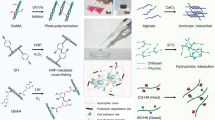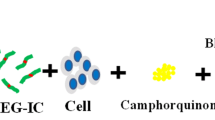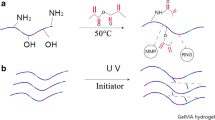Abstract
Enzyme-sensitive hydrogels are a promising class of materials for cell encapsulation and tissue engineering because their ability to be degraded by cell-secreted factors. However, it is well known that nearly all synthetic biomaterials elicit a foreign body response (FBR) upon implantation. Therefore, this study aimed to evaluate the in vitro and in vivo response to an enzyme-sensitive hydrogel. Hydrogels were formed from poly(ethylene glycol) with the peptide crosslinker, C-VPLS↓LYSG-C, which is susceptible to matrix metalloproteinases 2 and 9. We evaluated the hydrogel by exogenously delivered enzymes, encapsulated mesenchymal stem cells as a tissue engineering relevant cell type, and by macrophage-secreted factors in vitro and for the FBR through macrophage attachment in vitro and in a subcutaneous mouse model. These hydrogels rapidly degraded upon exposure to exogenous MMP-2 and to lesser degree with MMP-9. Encapsulated mesenchymal stem cells were capable of degrading the hydrogels via matrix metalloproteinases. Inflammatory macrophages were confirmed to attach to the hydrogels, but were not capable of rapidly degrading the hydrogels. In vivo, these hydrogels remained intact after 4 weeks and exhibited a classic FBR with inflammatory cells at the hydrogel surface and a fibrous capsule. In summary, these findings suggest that while this MMP-2/9 sensitive hydrogel is readily degraded in vitro, it does not undergo rapid degradation by the FBR. Thus, the long term stability of these hydrogels in vivo coupled with the ability for encapsulated cells to degrade the hydrogel makes them promising materials for tissue engineering.




Similar content being viewed by others
References
Amer, L. D., A. Holtzinger, G. Keller, M. J. Mahoney, and S. J. Bryant. Enzymatically degradable poly(ethylene glycol) hydrogels for the 3D culture and release of human embryonic stem cell derived pancreatic precursor cell aggregates. Acta Biomater. 22:103–110, 2015.
Anderson, J. Biological responses to materials. Annu. Rev. Mater. Res. 31:81–110, 2001.
Anderson, J. M., A. Rodriguez, and D. T. Chang. Foreign body reaction to biomaterials. Semin. Immunol. 20:86–100, 2008.
Aoki, T., H. Kataoka, M. Morimoto, K. Nozaki, and N. Hashimoto. Macrophage-derived matrix metalloproteinase-2 and -9 promote the progression of cerebral aneurysms in rats. Stroke 38:162–169, 2007.
Arpino, V., M. Brock, and S. E. Gill. The role of TIMPs in regulation of extracellular matrix proteolysis. Matrix Biol. 44–46:247–254, 2015.
Bahar-Shany, K., A. Ravid, and R. Koren. Upregulation of MMP-9 production by TNFalpha in keratinocytes and its attenuation by Vitamin D. J. Cell. Physiol. 222:729–737, 2010.
Bahney, C. S., C.-W. Hsu, J. U. Yoo, J. L. West, and B. Johnstone. A bioresponsive hydrogel tuned to chondrogenesis of human mesenchymal stem cells. FASEB J. 25:1486–1496, 2011.
Blakney, A. K., M. D. Swartzlander, and S. J. Bryant. The effects of substrate stiffness on the in vitro activation of macrophages and in vivo host response to poly(ethylene glycol)-based hydrogels. J. Biomed. Mater. Res. A 100:1375–1386, 2012.
Bracher, M., D. Bezuidenhout, M. P. Lutolf, T. Franz, M. Sun, P. Zilla, and N. H. Davies. Cell specific ingrowth hydrogels. Biomaterials 34:6797–6803, 2013.
Bryant, S. J., C. R. Nuttelman, and K. S. Anseth. Cytocompatibility of UV and visible light photoinitiating systems on cultured NIH/3T3 fibroblasts in vitro. J. Biomater. Sci. Polym. Ed. 11:439–457, 2012.
Bryant, S. J., and B. D. Ratner. Biomaterials: where we have been and where we are going. Annu. Rev. Biomed. Eng. 6:41–75, 2004.
Campbell, D. J., C. H. Kim, and E. C. Butcher. Chemokines in the systemic organization of immunity. Immunol. Rev. 195:58–71, 2003.
Cauwenberghs, S., M. A. Feijge, A. G. Harper, S. O. Sage, J. Curvers, and J. W. Heemskerk. Macrophage matrix metalloproteinase-2/-9 gene and protein expression following adhesion to ECM-derived multifunctional matrices via integrin complexation. FEBS Lett. 580:5313–5320, 2006.
Chellat, F., A. Grandjean-Laquerriere, R. Le Naour, J. Fernandes, L. L. Yahia, M. Guenounou, D. Laurent-Maquin, R. Le Naour, J. Fernandes, L. L. Yahia, M. Guenounou, and D. Laurent-Maquin. Metalloproteinase and cytokine production by THP-1 macrophages following exposure to chitosan-DNA nanoparticles. Biomaterials 26:961–970, 2005.
Cheng, K.-S., Y.-C. Liao, M.-Y. Chen, T.-C. Kuan, Y.-H. Hong, L. Ko, W.-Y. Hsieh, C.-L. Wu, M.-R. Chen, and C.-S. Lin. Circulating matrix metalloproteinase-2 and -9 enzyme activities in the children with ventricular septal defect. Int. J. Biol. Sci. 9:557–563, 2013.
Chung, E., and K. Healy. Biomimetic artificial ECMs stimulate bone regeneration. J. Biomed. Mater. Res. A 81:815–826, 2006.
Fairbanks, B. D., M. P. Schwartz, A. E. Halevi, C. R. Nuttelman, C. N. Bowman, and K. S. Anseth. A versatile synthetic extracellular matrix mimic via thiol-norbornene photopolymerization. Adv. Mater. 21:5005–5010, 2009.
Giannandrea, M., and W. C. Parks. Diverse functions of matrix metalloproteinases during fibrosis. Dis. Model. Mech. 7:193–203, 2014.
Goetsch, K. P., M. Bracher, D. Bezuidenhout, P. Zilla, and N. H. Davies. Regulation of tissue ingrowth into proteolytically degradable hydrogels. Acta Biomater. 24:44–52, 2015.
Greggio, C., F. De Franceschi, M. Figueiredo-Larsen, S. Gobaa, A. Ranga, H. Semb, M. Lutolf, and A. Grapin-Botton. Artificial three-dimensional niches deconstruct pancreas development in vitro. Development 140:4452–4462, 2013.
Hayakawa, T., K. Yamashita, E. Ohuchi, and A. Shinagawa. Cell growth-promoting activity of tissue inhibitor of metalloproteinases-2 (TIMP-2). J. Cell Sci. 107:2373–2379, 1994.
Hayakawa, T., K. Yamashita, K. Tanzawa, and K. Iwata. Growth-promoting activity of tissue inhibitor of metalloproteinases-1 (TIMP-1) for a wide range of cells. FEBS Lett. 298:29–32, 1992.
He, X., and E. Jabbari. Material properties and cytocompatibility of injectable MMP degradable poly (lactide ethylene oxide fumarate) hydrogel as a carrier for marrow stromal cells. Biomacromolecules 8:780–792, 2007.
Holloway, J. L., H. Ma, R. Rai, and J. A. Burdick. Modulating hydrogel crosslink density and degradation to control bone morphogenetic protein delivery and in vivo bone formation. J. Control Release 191:63–70, 2014.
Huang, W.-C., G. B. Sala-Newby, A. Susana, J. L. Johnson, and A. C. Newby. Classical macrophage activation up-regulates several matrix metalloproteinases through mitogen activated protein kinases and nuclear factor-κB. PLoS One 7:e42507, 2012.
Jay, S. M., E. Skokos, F. Laiwalla, M.-M. Krady, and T. R. Kyriakides. Foreign body giant cell formation is preceded by lamellipodia formation and can be attenuated by inhibition of Rac1 activation. Am. J. Pathol. 171:632–640, 2007.
Jha, A. K., W. M. Jackson, and K. E. Healy. Controlling osteogenic stem cell differentiation via soft bioinspired hydrogels. PLoS One 9:1–11, 2014.
Kim, S.-Y., J.-G. Lee, W.-S. Cho, K.-H. Cho, J. Sakong, J.-R. Kim, B.-R. Chin, and S.-H. Baek. Role of NADPH oxidase-2 in lipopolysaccharide-induced matrix metalloproteinase expression and cell migration. Immunol. Cell Biol. 88:197–204, 2010.
Koo, B.-H., M. Y. Park, O.-H. Jeon, and D.-S. Kim. Regulatory mechanism of matrix metalloprotease-2 enzymatic activity by factor Xa and thrombin. J. Biol. Chem. 284:23375–23385, 2009.
Lee, S. T., J. I. Yun, Y. S. Jo, M. Mochizuki, A. J. van der Vlies, S. Kontos, J. E. Ihm, J. M. Lim, and J. A. Hubbell. Engineering integrin signaling for promoting embryonic stem cell self-renewal in a precisely defined niche. Biomaterials 31:1219–1226, 2010.
Li, H., and T. Giorgio. Matrix metalloproteinase responsive, proximity-activated polymeric nanoparticles for siRNA delivery. Adv. Funct. Mater. 29:997–1003, 2012.
Lin, C.-C., C. S. Ki, and H. Shih. Thiol-norbornene photoclick hydrogels for tissue engineering applications. J. Appl. Polym. Sci. 132:41563, 2015.
Luan, Z., A. J. Chase, and A. C. Newby. Statins inhibit secretion of metalloproteinases-1, -2, -3, and -9 from vascular smooth muscle cells and macrophages. Arter. Thromb. Vasc. Biol. 23:769–775, 2003.
Lutolf, M. P., J. L. Lauer-Fields, H. G. Schmoekel, A. T. Metters, F. E. Weber, G. B. Fields, and J. A. Hubbell. Synthetic matrix metalloproteinase-sensitive hydrogels for the conduction of tissue regeneration: engineering cell-invasion characteristics. Proc. Natl. Acad. Sci. USA 100:5413–5418, 2003.
Lutolf, M. P., N. Tirelli, S. Cerritelli, L. Cavalli, and J. A. Hubbell. Systematic modulation of Michael-type reactivity of thiols through the use of charged amino acids. Bioconjugate Chem. 12:1051–1056, 2001.
Lutolf, M. P., F. E. Weber, G. H. Schmoekel, J. C. Schense, T. Kohler, R. Müller, and J. A. Hubbell. Repair of bone defects using synthetic mimetics of collagenous extracellular matrices. Nat. Biotechnol. 21:513–518, 2003.
Luttikhuizen, D. T., M. J. van Amerongen, P. C. de Feijter, A. H. Petersen, M. C. Harmsen, and M. J. A. van Luyn. The correlation between difference in foreign body reaction between implant locations and cytokine and MMP expression. Biomaterials 27:5763–5770, 2006.
Lynn, A. D., A. K. Blakney, T. R. Kyriakides, and S. J. Bryant. Temporal progression of the host response to implanted poly(ethylene glycol)-based hydrogels. J. Biomed. Mater. Res. A 96:621–631, 2011.
Lynn, A. D., T. R. Kyriakides, and S. J. Bryant. Characterization of the in vitro macrophage response and in vivo host response to poly(ethylene glycol)-based hydrogels. J. Biomed. Mater. Res. A 93:941–953, 2010.
McKinnon, D. D., A. M. Kloxin, and K. S. Anseth. Synthetic hydrogel platform for three-dimensional culture of embryonic stem cell-derived motor neurons. Biomater. Sci. 1:460, 2013.
Nagase, H., and G. B. Fields. Human matrix metalloproteinase specificity studies using collagen sequence-based synthetic peptides. Biopolymers 40:399–416, 1996.
Newby, A. C. Metalloproteinase expression in monocytes and macrophages and its relationship to atherosclerotic plaque instability. Arterioscler. Thromb. Vasc. Biol. 28:2108–2114, 2008.
Nicodemus, G. D., and S. J. Bryant. Cell encapsulation in biodegradable hydrogels for tissue engineering applications. Tissue Eng. Part B. Rev. 14:149–165, 2008.
Patterson, J., and J. A. Hubbell. Enhanced proteolytic degradation of molecularly engineered PEG hydrogels in response to MMP-1 and MMP-2. Biomaterials 31:7836–7845, 2010.
Quiding-Järbrink, M., D. A. Smith, and G. J. Bancroft. Production of matrix metalloproteinases in response to mycobacterial infection. Infect. Immun. 69:5661–5670, 2001.
Raza, A., and C. C. Lin. The influence of matrix degradation and functionality on cell survival and morphogenesis in PEG-based hydrogels. Macromol. Biosci. 13:1048–1058, 2013.
Rehman, A. A., H. Ahsan, and F. H. Khan. Alpha-2-macroglobulin: a physiological guardian. J. Cell. Physiol. 228:1665–1675, 2013.
Rhee, J. W., K.-W. Lee, D. Kim, Y. Lee, and O.-H. Jeon. NF-kappaB-dependent regulation of matrix metalloproteinase-9 gene expression by lipopolysaccharide in a macrophage cell line RAW 264.7. J. Biochem. Mol. Biol. 40:88–94, 2007.
Ries, C., V. Egea, M. Karow, H. Kolb, M. Jochum, and P. Neth. MMP-2, MT1-MMP, and TIMP-2 are essential for the invasive capacity of human mesenchymal stem cells: differential regulation by inflammatory cytokines. Blood 109:4055–4063, 2007.
Roberts, J. J., and S. J. Bryant. Comparison of photopolymerizable thiol-ene PEG and acrylate-based PEG hydrogels for cartilage development. Biomaterials 34:9969–9979, 2013.
Skaalure, S. C., U. Akalp, F. J. Vernerey, and S. J. Bryant. Tuning reaction and diffusion mediated degradation of enzyme-sensitive hydrogels. Adv. Healthc. Mater. 5:432–438, 2016.
Sokic, S. Enhanced degradation and peptide specificity of MMP-sensitive scaffolds for neovascularization of engineered tissues. ProQuest Diss. Publ. 2013.
Sridhar, B., and K. S. Anseth. Development of a cellularly degradable PEG hydrogel to promote articular cartilage extracellular matrix deposition. Adv. Healthc. Mater. 4:702–713, 2015.
Swartzlander, M. D., C. A. Barnes, J. L. Blakney, J. L. Kaar, T. R. Kyriakides, and S. J. Bryant. Linking the foreign body response and protein adsorption to PEG-based hydrogels using proteomics. Biomaterials 41:26–36, 2015.
Swartzlander, M. D., A. D. Lynn, A. K. Blakney, T. R. Kyriakides, and S. J. Bryant. Understanding the host response to cell-laden poly(ethylene glycol)-based hydrogels. Biomaterials 34:952–964, 2013.
Tian, W., and T. R. Kyriakides. Matrix metalloproteinase-9 deficiency leads to prolonged foreign body response in the brain associated with increased IL-1beta levels and leakage of the blood-brain barrier. Matrix Biol. 28:148–159, 2009.
Timms, P. M., N. Mannan, G. A. Hitman, K. Noonan, P. G. Mills, D. Syndercombe-Court, E. Aganna, C. P. Price, and B. J. Boucher. Circulating MMP9, vitamin D and variation in the TIMP-1 response with VDR genotype: mechanisms for inflammatory damage in chronic disorders? QJM—Mon. J. Assoc. Phys. 95:787–796, 2002.
Turk, B. E., L. L. Huang, E. T. Piro, and L. C. Cantley. Determination of protease cleavage site motifs using mixture-based oriented peptide libraries. Nat. Biotechnol. 19:661–667, 2001.
Turturro, M. V., M. C. Christenson, J. C. Larson, D. A. Young, E. M. Brey, and G. Papavasiliou. MMP-sensitive PEG diacrylate hydrogels with spatial variations in matrix properties stimulate directional vascular sprout formation. PLoS One 8:e58897, 2013.
Wang, H., D. N. Udukala, T. N. Samarakoon, M. T. Basel, M. Kalita, G. Abayaweera, H. Manawadu, A. Malalasekera, C. Robinson, D. Villanueva, P. Maynez, L. Bossmann, E. Riedy, J. Barriga, N. Wang, P. Li, D. A. Higgins, G. Zhu, D. L. Troyer, and S. H. Bossmann. Nanoplatforms for highly sensitive fluorescence detection of cancer-related proteases. Photochem. Photobiol. Sci. 13:231, 2014.
Acknowledgments
Research reported in this publication was supported by the National Institute of Arthritis and Musculoskeletal and Skin Diseases of the National Institutes of Health under Award Number 1R21AR064436 and by and by the Department of Education’s Graduate Assistantships in Areas of National Need fellowship to LDA.
Author information
Authors and Affiliations
Corresponding author
Additional information
Associate Editor Michael S. Detamore oversaw the review of this article.
Rights and permissions
About this article
Cite this article
Amer, L.D., Bryant, S.J. The In Vitro and In Vivo Response to MMP-Sensitive Poly(Ethylene Glycol) Hydrogels. Ann Biomed Eng 44, 1959–1969 (2016). https://doi.org/10.1007/s10439-016-1608-4
Received:
Accepted:
Published:
Issue Date:
DOI: https://doi.org/10.1007/s10439-016-1608-4




